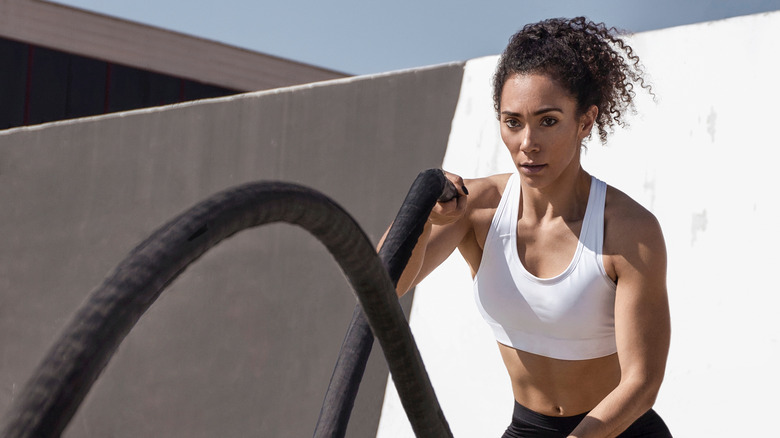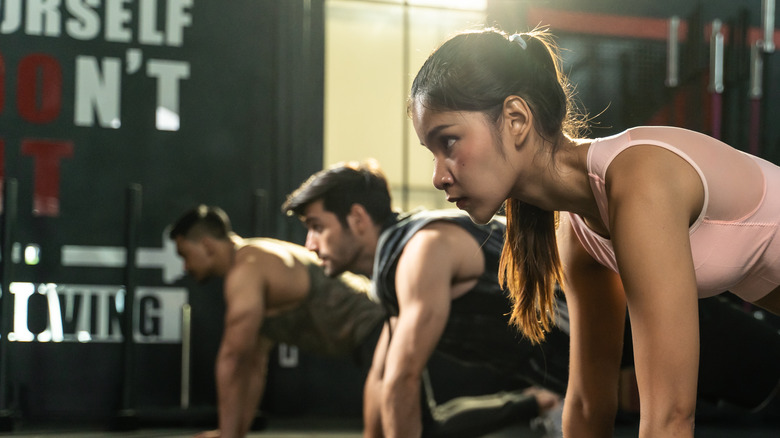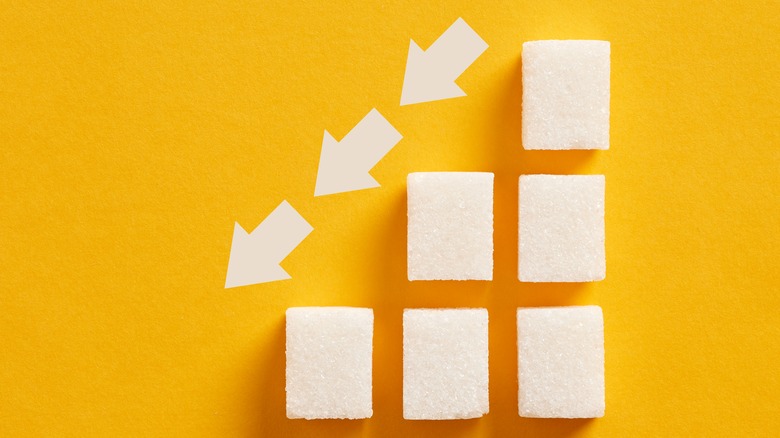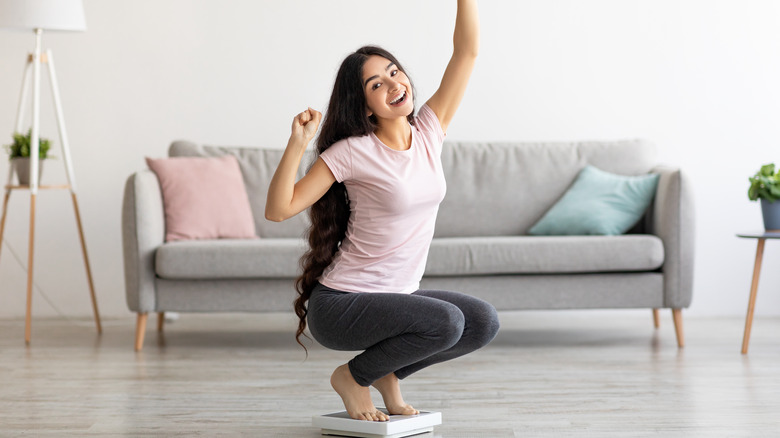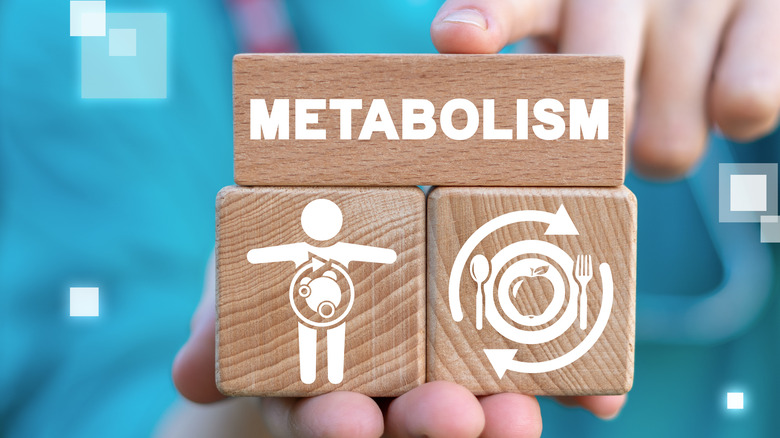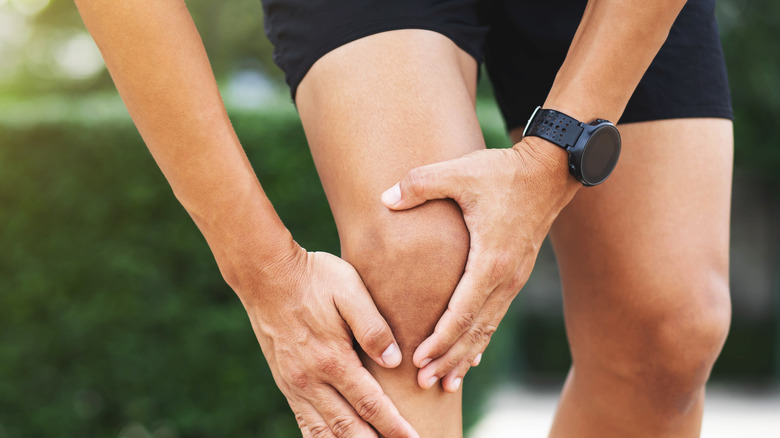What Happens To Your Body When You Do CrossFit Every Day
You've probably heard of CrossFit. Its origins stretch back to the year 2000, according to The New Yorker. While you may think of the workout as simply a collection of intensely demanding moves, CrossFit is actually an established brand founded by a man named Greg Glassman. Since its inception, CrossFit has gained somewhat of a cult following, with its approximately 4 million devotees spread across 13,000 official gyms around the world, with 7,000 of them being in the United States (per NBC News).
If you're at all familiar with CrossFit, you probably already know that it is a challenging workout. NBC News explains that it's a form of High Intensity Interval Training (HIIT) that relies on "functional movements" exercise done at a high level of intensity. The foundation of the workout is that the exercises replicate moves you perform on a daily basis including squatting, reaching, pulling, and pushing, according to the news site. Some of the particular exercises you'll see featured in a CrossFit class include squats, pull-ups, burpees, as well as weight lifting.
One thing is certain, if you take up CrossFit you're going to see some major changes in your physique and overall health. Because you want to learn just how performing this workout on the daily will transform your body, continue reading.
You will gain strength
If you are looking for a workout that is going to increase your overall strength, CrossFit may be your new go-to. Two CrossFit experts spoke to Men's Journal about which moves you can use to help boost your strength. Angela Salveo, co-owner of CrossFit Salus in Middletown, NJ starts out by explaining that the "Crossfit Total" move, which is made up of "the back squat, shoulder press, and deadlift" is a good way to evaluate where you stand strength wise. This tests what is called your "one rep max," which is the maximum amount of weight you can lift in a single repetition. To get to that number, Salveo recommends doing three reps of the CrossFit total: One with a weight you know you can bear for three repetitions, the next highest you can do for one rep, and finally, your goal lift based on how you did with the previous two.
Another strengthening combination of moves are squats and sprints. Jessica Murden, co-owner of CrossFit A.C.T. in Saddle Brook, NJ, explains, "This is the type of workout that pushes your strength to the limits, maybe even eliciting a few cries toward the last couple of rounds," Murden says. "Squatting heavy is a high force/low speed movement, while sprinting is a high force/high speed movement. When you marry these two together, a beautiful union of strength and speed gains occur."
You will build muscle
After doing those workouts, your strength is up, but what about your muscles? If beefing up is next on your list of to-do's CrossFit has you covered here as well. Aaron Karp, exercise physiologist at the Hospital For Special Surgery's Tisch Sports Performance Center spoke to PopSugar and explained that HIIT workouts such as CrossFit can absolutely help you gain muscle mass. "There are certainly certain types of HIIT workouts that are better than others for building muscle, but in general, they can," he explained to the site. Moves found in CrossFit such as squats, lunges, deadlifts done "in a series will lead to muscle fatigue, and at the end of the day, that's how you build muscle." he explained further.
Dr. Zach Long, physical therapist in Charlotte, North Carolina writes on his website, The Barbell Physio, that while doing CrossFit may not lead to muscular gains that will leave you looking like The Rock, you can still gain significant muscle mass if you follow certain protocols. He says that increased muscle growth is positively correlated with training volume, and that CrossFit specifically focuses on "increased volumes of training in a given time," while thoroughly working all of the major muscle groups. To add even more volume to your training he suggests adding "10-15 minutes of extra work 3-4 days per week spread throughout the traps, deltoids, biceps, and triceps," for more gains.
Your endurance will improve
If you're an athlete, or simply someone who wants to increase their stamina, regularly doing CrossFit may help you reach your goals. In a review published by the Journal of Sport and Health Science, researchers examined the effect HIIT workouts (such as CrossFit) had on recreational endurance runners on both a short and long term scale. In the studies evaluated by the review, a group of runners did one HIIT exercise, two to four times a week combined with running. Researchers assessed their "physiological, neuromuscular, metabolic and/or biomechanical variables," and found that HIIT combined with running two to three times a week improved their athletic performance by way of improving oxygen uptake, running economy, and "muscular and metabolic adaptations."
Another small study published by Biology of Sport confirms these previous findings. The study observed nine overweight and obese men and nine men with a healthy weight, and subjected them to a HIIT training three times a week. After the training, researchers found that "maximal aerobic velocity" increased significantly for both groups, and that their sprint times also decreased.
Blood sugar might decrease
You may not have thought about the possibility that CrossFit could lower your blood sugar, but science says it is indeed true. In a study published by the British Journal of Sports Medicine, researchers studied the short and long term effects of HIIT workouts on overweight and obese people. Short term, the researchers found that fasting blood sugar was improved in the subjects after 12 weeks or less of working out.
Healthline also points out that a summary of 50 studies corroborates this evidence, explaining that in addition to reducing blood sugar, HIIT also "improves insulin resistance more than traditional continuous exercise," according to the site. Experts at the site explain that for this reason, HIIT workouts including CrossFit may be a good option for those who have diabetes. Studies have already shown that HIIT exercises have proven beneficial at managing blood sugar levels for people dealing with the disease, and that it is also helpful for those who don't have it.
Furthermore, the American Medical Association recommends doing HIIT to help manage prediabetes, and explains that these types of exercises help improve glucose control "over a longer period."
Your heart health may improve
It's no secret that exercising is good for your heart. Experts at Harvard Health explain that exercises like CrossFit are (generally speaking) included in the good-for-your-heart club, but also caution that those who are older or who have heart disease may want to pump the breaks. Dr. I-Min Lee, professor of medicine at Harvard Medical School, spoke to the University's website and explained, "HIIT is a great regimen for people who are young and healthy. If you're older or have heart disease, check with your doctor before trying it." The site explains that CrossFit can offer heart health benefits to exercisers because instead of working for longer, you are working harder. In fact, some studies show that HIIT exercises may be even better for your blood pressure than moderate-intensity exercise.
Medical News Today shares that doing HIIT workouts can both help improve heart health for those who are already healthy, and can help those with heart conditions manage them better. As previously mentioned, this type of exercise can help improve blood sugar, and can also improve blood pressure, and cholesterol, which are all connected to heart disease (via the Centers for Disease Control and Prevention).
You might lose weight
Want to shed pounds? Hit that CrossFit gym and watch them melt away. According to experts at Livestrong, if you had doubts about whether CrossFit was a good workout to help you lose weight, the answer is a resounding yes. Mike Molloy, PhD, owner of M2 Performance Nutrition, says, "There are many people out there who have experienced significant weight loss by using the general five-days-a-week template with CrossFit." The workout is structured in such a way that it naturally leads to calorie burning. Molloy says that the mixture of strength training, aerobics, and HIIT all combine to help you "lose weight and lean out." Livestrong experts say the data shows that CrossFitters burn an impressive 2,700 calories a week in only five hours and 15 minutes of working out, which should ideally lead to significant weight loss for those who are overweight or obese.
CrossFit community member Tom Baker, who is also the manager of CrossFit Sanitas explained that "Although steady-state cardio — long runs, for example — burn more calories during the activity itself, the process stops when you stop, while weightlifting triggers a recovery response in your body that allows it to continue to burn calories long after the work is completed." To make sure you are getting the most out of your weight loss plan, experts at Livestrong suggest pairing CrossFit with a healthy diet filled with "meat, vegetables, nuts, and seeds," to maintain progress.
Your metabolic rate will increase
Another advantage of doing CrossFit versus some other more traditional forms of exercise, according to Healthline, is that it can actually increase your metabolic rate, or the rate at which you burn calories. Your metabolism is another way to describe a set of chemical reactions that occur in your body to help you convert nutrients from the food you eat into energy (via Healthline). The site explains that HIIT exercises have been scientifically proven to increase your metabolic rate for hours after you finish exercising. That means that your body is still burning calories from your workout long after you've finished squatting, doing pull-ups, and are on your way home to rest.
What's more, a study published by the Sports Medicine Open journal, observed 20 "recreationally active women," who completed a total of six exercises based on three different types of workouts. The workouts were divided into aerobic endurance exercising, HIIT, and high-intensity resistance training (HIRT). The study found that the metabolic rate was higher for the women after they completed the HIIT training than when they finished the aerobic exercise and the HIRT exercises. Furthermore, the study concluded that HIIT increases the body's ability to burn fat to fuel its energy rather than using carbs, according to Healthline. As an added bonus, researchers found that consuming protein pre-workout increased the metabolic rate for study participants.
It may help improve arthritis
If you are dealing with arthritis, doing a HIIT such as CrossFit could prove beneficial. The Arthritis Foundation explains that several studies have concluded that HIIT is a good option for those who have rheumatoid arthritis (RA). Numerous studies have shown that participants who engaged in HIIT training "lost weight, gained muscle and improved their joint health without any increase in inflammation or pain," according to the site. A study at Duke University confirmed that HIIT workouts reduce inflammation that is caused by rheumatoid arthritis. As for how it happens, experts explain that this type of exercise "shifts metabolic substrates to skeletal muscle (for enhanced protein synthesis and fat oxidation) and away from circulating immune cells, resulting in reductions in systemic inflammation."
Another study published by ACR Open Rheumatology observed 29 older adults that had knee osteoarthritis under a 12-week HIIT program. The study evaluated cardiorespiratory fitness, strength, body composition, and isometric knee extensor/flexor strength among other factors, and found that almost all of these areas improved after the program ended.
In general, exercise has been proven to reduce inflammation, and Medical News Today reports that just 20 minutes of it a day can prevent or reduce inflammation that may lead to joint pain.
Your mood may get a boost
Much research has been done to highlight how beneficial exercise is for your mood. However, new research has shown that HIIT may be particularly beneficial for alleviating symptoms of depression. The journal Frontiers in Psychology conducted a study on 36 healthy women that did a total of 24 HIIT training sessions in eight weeks at three times a week. They evaluated the women's anxiety and depression levels, and researchers discovered that HIIT exercises improved depression symptoms, but not anxiety.
Another study by the Iranian Journal of Public Health observed 20 young males divided into two groups: overweight and obese, and normal weight. The researchers subjected them to a HIIT training program for eight weeks and found that after the trial was done, the men reported decreased feelings of "negative moods tension," and depression.
In case you are skeptical about the cause-effect relationship between working out and seeing improvements in your mood, Harvard Health conducted a study to examine exactly that. Karmel Choi, a clinical and research fellow at the Harvard T.H. Chan School of Public Health conducted a study to get clear on the data. "Does physical activity protect against depression? Or does depression simply reduce physical activity?" he asked when speaking to the site. Ultimately, the study found that those who move are independently reducing the risk of depression. So if your mood is low, head to the closest CrossFit gym and put some sweat in.
Your immune system may take a hit
While there are a lot of positive benefits of doing CrossFit, one potentially negative side effect is that it may actually do damage to your immune system if you do it too much. While you may be thrilled about the progress you're getting in the gym and want to go every day, it's suggested that you take some breaks. Experts spoke to Sports Illustrated to explain that rest days while doing CrossFit are key to maintaining a healthy immune system.
The website cites a study published in the journal Frontiers in Physiology that observed nine males that conducted back to back CrossFit sessions. The researchers found that after doing the workouts over two days, the subjects experienced what Sports Illustrated calls a "drop in anti-inflammatory immune system proteins." The site explains that these proteins are created by white blood cells which protect the body from both illness and infection. Author of the study, Ramires Tibana, PhD, spoke to Sports Illustrated and explained, "For non-athlete subjects who want to improve their health and quality of life through Crossfit training, we recommend that they decrease their training volume after two consecutive days of high intensity training to prevent possible immunosuppression."
Your oxygen consumption will improve
Circling back to the positive side effects of CrossFit, another benefit is that this workout will significantly increase your oxygen consumption. To start off, Healthline defines oxygen consumption as "your muscles' ability to use oxygen." The site says that typically people engage in endurance training as a way to up their oxygen consumption, but research has shown that HIIT workouts like CrossFit are just as good at improving oxygen intake, and in a fraction of the time. A study published by PLoS One found that those who perform 20 minutes of HIIT exercise a day for four days a week over five weeks total saw a 9% increase in their oxygen consumption. A second group in the study cycled continuously for 40 minutes over four weeks and saw similar results, which is to say the HIIT group experienced the same results in half the time.
As for why oxygen consumption is important, research published in the journal Clinics in Chest Medicine explains that higher levels of oxygen consumption essentially equals higher endurance levels. Basically, this means the fatigue you experience during your workouts that prevents you from continuing is due to a lack of oxygen circulating in your tissues. The research published in the journal explains that over time, your muscles adapt to the high levels of oxygen in your muscles from this type of training, which can improve endurance in the long run.
Your sleep may improve
Insomniacs take note: CrossFit may be a great way to knock you out — in a good way, of course. A review published by the International Journal of Environmental Research and Public Health evaluated the effects of HIIT on sleep for adults and found that there was a significant increase in sleep quality for those that had conducted the exercises. The study also found that those who did HIIT workouts at least three times a week reduced the amount of time spent awake in bed.
In general, there are many positive correlations between sleep and exercise, and the experts at The Sleep Foundation explain that there is what is called a "bidirectional" relationship between the two. This means that exercising more can help you sleep better, and getting better sleep can give you more energy to work out. The site explains that "moderate-to-vigorous exercise" can help improve sleep quality for adults and limit the amount of time it takes you to fall asleep.
You may be at greater risk of injury
One potential downside of CrossFit is that it may increase your risk of being injured during a workout. The experts at Iron Bull Strength say that while yes, CrossFit is a great workout for building strength, muscle and general fitness, it does come with some risks. In one particular study published by The Orthopedic Journal of Sports Medicine, researchers surveyed 553 CrossFitters, and found that of 449 respondents, 252 of them experienced injuries as a result of their workouts, which is to say, more than half. The most common areas injured were the shoulders, lower back, and knee, according to the study. Experts at Iron Bull Strength explain that the reason for so many injuries during CrossFit are a result of overusing muscles, and that it is possible to avoid injury with proper education.
When advising on how to avoid wrist strain injury, the site advises CrossFitters to warm up and stretch this area prior to working out to avoid strain. The wrists are used in many CrossFit workouts, and are typically a fragile area of the body, according to the site. You can also use "wrist wraps" to help avoid strain. To avoid Achilles tendonitis, the site suggests making sure you are wearing the right shoes, stretching properly pre-workout, and getting foot reflexology done at least once a month.

